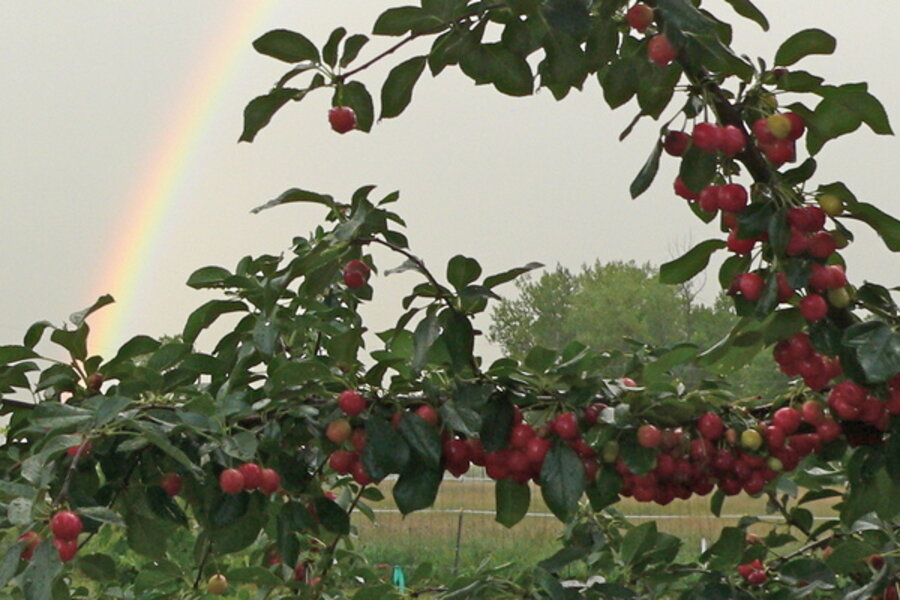Growing cherries on the Colorado Front Range
When the sun came out after a blustery afternoon thunderstorm several days ago, rain kept on falling for nearly half an hour, coming in all lit up at a slant. You get to see a lot of sky and weather on the Plains because there aren’t many trees; conditions are harsh for them.
Against the horizon, a rainbow framed our small mixed orchard where I’ve been picking cherries off and on for weeks, reminding me to get out there again now that the North Star’s branches are drooping with the weight of its plump, red fruit.
Nanking, Montmorency, and North Star
First come the shrubby, drought-tolerant Nankings planted in a hedgerow for the birds. The fruit is small, too small for most to bother with, but it’s an unusually sweet treat since tart pie cherries are what grow best on the Colorado Front Range.
The Nankings’ fruit was especially abundant this year but the birds seem to prefer the larger Montmorency cherries, and will strip the tree bare in a few days of joyful, raucous feasting if it's left uncovered, so, for humans, it’s catch-as-catch-can when it comes to cherries.
Most bird netting doesn’t work in my experience; the birds get caught in it, especially young ones, so you have to disentangle them, which is not pleasant. A fine mesh is better.
I wrap row cover around the tree and fasten it with clothespins because I have the materials on hand. It isn't especially professional looking, but it works; you only need it for a week or two.
By the time the North Star cherries are ready to harvest a couple of weeks later, the birds seem less excited. The cherries are more difficult for them to pluck off, though easier for me since the tree is just seven feet high.
Maybe the birds have had their fill or don’t like them as well, but there are always plenty for everybody. Left to ripen in hot weather these cherries verge on sweet. And unlike Montmorency, North Star doesn’t need a pollinator.
Erratic spring weather
The main problem with growing cherries on the Colorado Front Range is our seesawing spring weather. Unlike the more gradual warm-up of gentler climates, even those with cold winters, we have warm to hot weather alternating with spring freezes and temperatures too cold for bees to venture out and pollinate.
Here trees are coaxed out of dormancy early only to be hammered by killing frosts.
One way around this is to plant fruit trees on the north side of buildings where the area remains shaded and cooler early in the season while the sun is still low in the sky. Just make sure they get several hours of sun by mid-April.
Even so, this is no guarantee. Pie cherries were a big commercial crop along the Front Range foothills near Fort Collins and Boulder until 1949, when a severe frost wiped out every single tree.
Cherries, both sour and sweet, are much more reliable on Colorado’s Western Slope, where fruit orchards of all types abound, especially near Palisade. The sweet cherries, mostly Bing and Rainer, come first, from June 20 to July 10. Pie cherry season is July 15 to 25.
Despite our harsh conditions, I planted two very hardy sweet cherries a couple of years ago on the north side of the house, Blackgold and Kristin, and this year picked one delicious cherry from each. With compost tea soil drenches, winter watering, and a thick layer of mulch to retain moisture I’m optimistic about the future.
-----
Jane Shellenberger lives on five acres at 5,000 feet on the plains in Hygiene, Colo., between Boulder and Longmont. She is the publisher and editor of Colorado Gardener, "a thinking gardener's companion." Her book, "Organic Gardener's Companion: Growing Vegetables in the West," will be available in spring 2012. To read more by Jane here at Diggin' It, click here.






